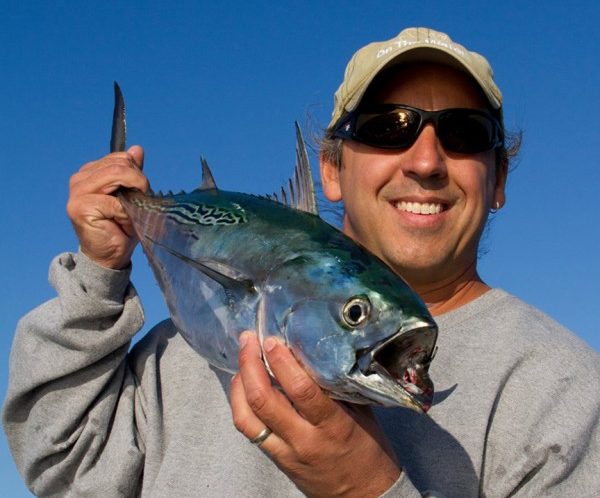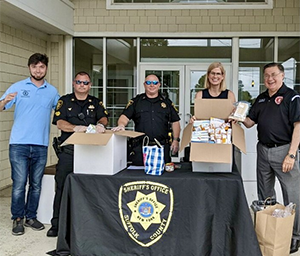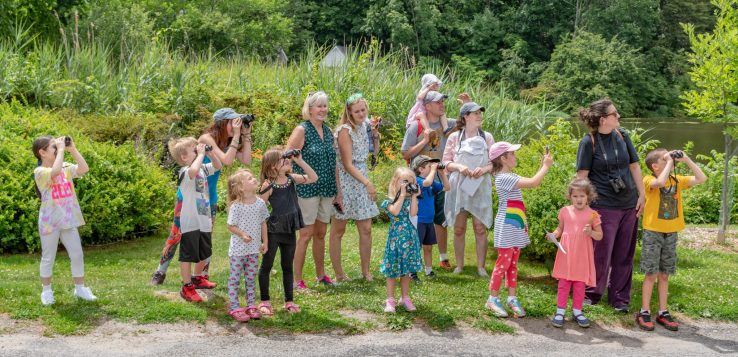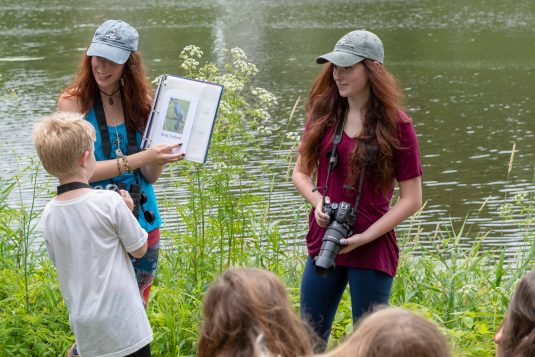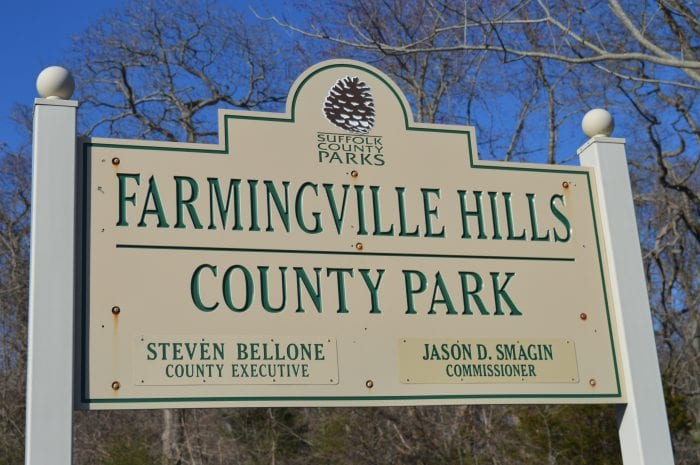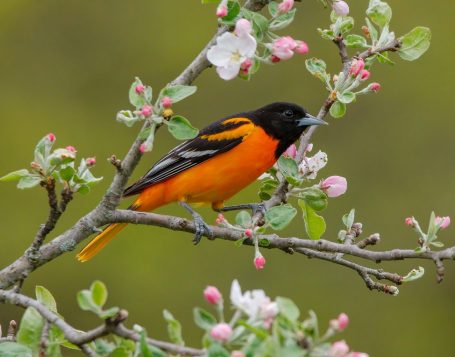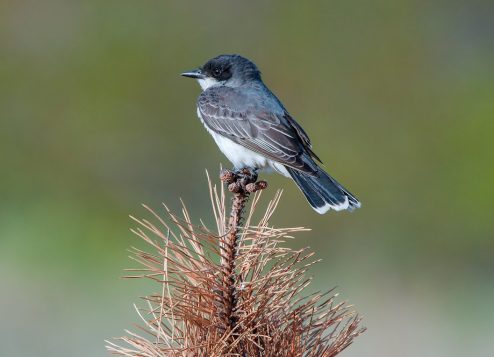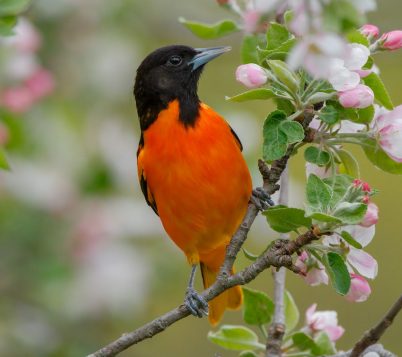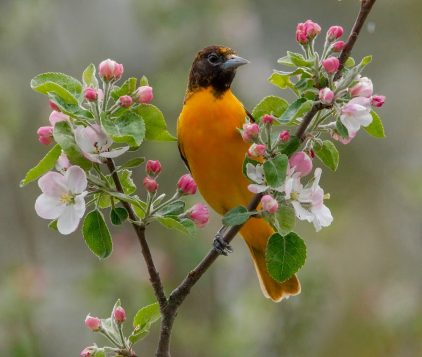Join Comsewogue Public Library in Port Jefferson for a online program, From Plankton to Whales: Protecting Local Waters, on Wednesday, July 14 at 7 p.m. Find out why our local waters are worth protecting by learning about some of the fascinating marine life that inhabits the waters of Long Island with Chris Paparo. Open to all. Free. Hosted by Comsewogue Public Library. Visit www.cplib.org/a-online-programming/ for information on how to participate in this online program. Questions? Call 631-928-1212 and ask for Adult Services.
E-Waste, Paper Shredding and Drug Take Back event in Mount Sinai a success

On June 26, Councilwoman Jane Bonner held her first E-Waste Collection, Paper Shredding and Drug Take Back event of 2021 at the Rose Caracappa Senior Center in Mount Sinai. The event provided the opportunity for residents to safely dispose of unused electronic devices, have their old paper documents securely shredded, and to safely dispose of old prescription drugs.
This special recycling event was co-sponsored by DIME Community Bank. Members of the Suffolk County Sheriff’s Department were also on-hand to accept the prescription drugs for disposal. Over 500 cars stopped by to recycle 21,780 lbs. of paper, 11,600 lbs. of e-waste and 15 boxes of unwanted prescription drugs for proper disposal.
“My first 2021 recycling event of the year was an overwhelming success. It’s great to know that we can provide a helpful alternative that allows the public to recycle right and dispose of unused or expired drugs in a safe manner. I thank the Sheriff’s Department for their participation and all the people who came out to help keep Brookhaven clean and green,” said Councilwoman Bonner.
Cayla’s Column: Children’s Birding Adventures take flight
By Cayla Rosenhagen

“Look, look! There’s a bird up in this tree … and there’s a nest, too!”
A young boy with binoculars pressed against his face cheerfully announces what he has found. An American Robin flies to her nest, cozily tucked in a nearby cedar; the child notices she has a worm in her bill. More young birders gather to watch in awe of the mother robin feeding her recently hatched chicks.
Nothing compares to watching a child’s face light up with happiness and fascination as they become immersed in the world of birds. I had the joy of seeing this firsthand. On June 27th, my sister Iris and I launched the first Children’s Birding Adventure at Frank Melville Memorial Park in Setauket for Four Harbors Audubon Society.
The event began early in the afternoon at the entrance to the park, as enthusiastic families circled around to introduce themselves on the lawn overlooking the lake. Their children ranged in age from infancy to age 10 and were bubbling over with questions and stories about wildlife they had seen. One of the participants, Olivia, 8, a birder for about two years, looked forward to seeing a Northern Cardinal, one of her favorite backyard birds.
Before our walk began, the children engaged in a round of nature-inspired activities, including Sparrow Says (Simon Says with an aviary twist) and a storytime, featuring a book by Kermit Cummings entitled A Backyard Birding Adventure: What’s in Your Yard? To further their birding knowledge, we presented the budding ornithologists with a photo album of birds we were likely to spot on our adventure. Bird BINGO cards, illustrating the same feathered friends, were handed out to all the children so they could record their sightings in a novel manner. Each youngster was then lent a pair of child-sized binoculars and taught how to use them.
Eagerly, we headed down the path encircling the picturesque Mill Pond. As we strolled the half-mile paved loop, a dozen children and their families surveyed their surroundings for birds and were met with great success. Catbirds, swallows, woodpeckers, swans, and warblers filled the lenses of every pair of binoculars. Little eyes spotted blue jays, sparrows, and egrets; the children announced their birding discoveries to the group with delight. The group paused along the old stone bridge and I pointed out turtles on a floating log and the blackbirds who nest in the nearby reeds. When birds weren’t readily in sight, scurrying chipmunks, zigzagging butterflies, and the iridescent wings of dragonflies captivated the young minds. As the hour-long event came to a close, it was so gratifying to hear from both parents and kids alike that fun was had by all, and much was learned about the natural world.
The members of Four Harbors Audubon Society have been my role models and mentors for many years and continue to inspire me. I started participating in their monthly bird walks when I was the age of many of the children who attended Saturday’s event. At age 16, I now serve on the Board of Directors for 4HAS, and it is a privilege for me to contribute to the younger generation’s love and appreciation of birds. Who knows? Birding may become a lifelong passion for them, as it has for me.
In the future, Four Harbors Audubon Society plans to run the Children’s Birding Adventures on a seasonal basis. If you are interested in joining us for our next program, please email us at [email protected].
Cayla Rosenhagen is a local high school student who enjoys capturing the unique charm of the community through photojournalism. In addition to the Four Harbors Audubon Society, she serves on the board of directors for Brookhaven’s Youth Board, and is the founder and coordinator of Beach Bucket Brigade, a community outreach program dedicated to environmental awareness, engagement, and education. She is also an avid birder, hiker, and artist who is concurrently enrolled in college, pursuing a degree in teaching.
Farmingville Hills County Park to be renamed
At the General Meeting of the Suffolk County Legislature on June 24, Legislator Nick Caracappa’s bill, IR 1408-2021 was adopted with a unanimous vote.
The intent of the resolution is to honor a former colleague of the Legislature, Tom Muratore, who passed away suddenly on September 8, 2020. Pursuant to Section 215(1) of New York County Law, Farmingville Hills County Park will hereby be renamed “Thomas Muratore County Park.” As the introductory resolution states,

“it would be fitting to name Farmingville Hills County Park in honor of Thomas Muratore to acknowledge his contributions to Suffolk County as someone who dedicated his entire life to public service and reached across the aisle to better the lives of County residents, especially when it came to working together to protect families, our veterans and our quality of life.”
Legislator Caracappa, who serves the Fourth Legislative District where Muratore served previously, is very pleased with the outcome.
“It was a great day at the Suffolk County Legislature, where my bill to rename Farmingville Hills County Park in honor of my friend and a true public servant, Tom Muratore passed unanimously! Tom’s entire career revolved around serving and helping the people of Suffolk County; first as an officer in the SCPD, then as a County Legislator. Thank you to my colleagues for their support, Chairman Jesse Garcia, Chairman Rich Schaefer, the entire Board of Supervisors, and all residents/organizations within the 4th Legislative District for their support and encouragement in seeing this wonderful bill through the process. Congratulations to Linda Muratore and Tom’s entire family on this well-deserved recognition!”
Photo of the Week
BLAZE OF GLORY
Tom Caruso of Smithtown snapped this beautiful photo during a walk in Stony Brook Village on June 16. He writes, ‘My wife and I were walking down the road leading to the water when I saw these Orange Daylilies blazing in the light of the setting sun. I shot this image with my cell phone and was amazed at the contrast between the flowers and their surroundings.
Send your Photo of the Week to [email protected]
Movie Review: ‘Breaking Boundaries —The Science of Our Planet’
Reviewed by Jeffrey Sanzel
Netflix’s Breaking Boundaries: The Science of Our Planet explores the idea that humanity has pushed the planet beyond survival and sustainability. While ably hosted by the ever-reliable Sir David Attenborough, the dominant voice is Swedish Professor Johan Rockström, an informed and articulate scientist with a range of facts and concepts that he introduces over the one hour and fifteen-minute running time.

There are few topics — if any — more important than the future of Earth. And while some make claims against it, climate change, global warming, and other man-driven destructions are real and present dangers, ones that seem to be growing geometrically. This documentary attempts to explain these issues by setting down a theory of boundaries. It then proceeds to explain how they are being crossed.
Breaking Boundaries opens with a discussion of the stability of Earth’s temperature and climate for 10,000 years; this allowed for the development of the modern world. The documentary then proceeds to cite examples of our destructive behaviors and how they have negatively impacted various ecosystems, including the Amazon, the Great Barrier Reef, etc. Rockström’s refrain is, “It is not about the planet. It is about us. About our future.” Perhaps he is trying to appeal to our self-centered nature rather than our desire to correct what we have broken. Unfortunately, his slightly skewed sense of humanity is probably well-founded.
The film starts with a glimmer of hope, but five minutes in, the bad news is announced: over the past fifty years, we have pushed ourselves out of the norm that existed the previous 10,000 years. And there may be no fix for this situation.
Over the next fifty minutes, a disjointed narrative attempts to explain the nine planetary boundaries — the distance from the safe zone to the danger zone to the high risk/critical zone. Carbon dioxide in the atmosphere has caused droughts, heatwaves, forest fires, and flooding. Ocean acidification, the dangers of aerosols, and novel entities of human pollution are just some of the ideas introduced. Thus, there is an immediate need not just to reduce but to fossil-free within three decades.

Scientists meditate on the destruction of the icecaps, evaluate the reduction of flora and fauna to the point of extinction, and offer a great number of numbers that sometimes seem like … a great number of numbers. (Overwhelming statistics and an extraordinary list of theories make for a bit of confusion.) Finally, the film circles back to the four boundaries that have been crossed and possibly irrevocably (but maybe not?): climate, forest loss, nutrients, and biodiversity.
Every bit of this is important information. But the problem comes down to this: Breaking Boundaries is a documentary dealing with a life-and-death topic in a clumsy and wrong-headed approach. Director Jonathan Clay has underestimated his audience, deciding that an MTV assault is the only way to connect. As a result, the bells and whistles drown out the material. Yes, they are alarm bells and fire whistles, but this is an onslaught, not an explanation.
One talking head goes so far as to refer to the “Mad Max future.” A drinking game based on the repetition of “tipping point” and “irreversible” would put the players out in under twenty minutes. There is probably truth in every statement and comment. But judicious editing would have allowed for a variety of tactics, rather than what comes across as a relentless, one-note attack.
The effects are overwhelming and non-stop, with even the most sedate moments backgrounded with a strange light show. (Was this Mr. Clay’s first time with a green screen?) The graphics seem to be inspired by the 1980s’ Tron. Or perhaps Saturday Night Fever. Everything explodes on screen, making for restless, jittery filmmaking. The result wholly lessens the film’s integrity.
Many moments succeed in capturing the beauty of nature. If a bit generic, they serve as a strong reminder of what is being destroyed. Some disturbing images are not sensational but instead are telling: wild animals who now live close to settled and “civilized” areas are shown in droves on highways and the environs of cities. While we are always warned not to anthropomorphize, there is a palpable fear in their eyes.

There are two moments of resonating humanity. First, a scientist discussing the bleaching of the Great Barrier Reef becomes choked up, clearly a spontaneous and honest reaction to what he has seen. Second, a conservationist revisits one of the sites where she had studied birds before its incineration. The destruction of fifty million acres of Australian land caused the displacement or death of an estimated three billion animals. While she looks at the bleak landscape, she says, “This is an ecological catastrophe.” But this is also highly personal and, again, powerful in its simplicity.
If only the director had trusted moments like these. Instead, he chose window dressing that makes the experience a late-night infomercial for the predictions of Nostradamus.
After fifty-nine minutes of apocalyptic prognostication, there are twelve minutes of “but-it-can-all-be-saved.” We need to bend the global curve of emissions, cutting 6 to 7% per year. We can draw down the carbon by planting more trees. Changing our diets to healthy foods will contribute to the saving of the planet. We can eliminate waste by turning the linear cycle into a circular one by recovering raw materials (and benefit the economy). Finally, we must turn towards renewable energy. “The window is still open.” Rockström believes that 2020 to 2030 is the decisive decade: what happens in these ten years will determine what happens over the coming centuries.
Perhaps there is no longer a way to make people listen — and more importantly, take action — without being sensationalist. However, this film will win no converts and will probably not engage the already aware and committed. The call is to act as “earth’s conscience — it’s brain — thinking and acting with one unified purpose — to ensure that our planet forever remains healthy and resilient — the perfect home.” It is not just a noble purpose but an essential one. There have been, and there will be many valuable examinations of this subject matter. Unfortunately, in the end, Breaking Boundaries is not one of them.
Nature Matters: The Baron and the King
By John L. Turner
For me, it is the most anticipated song of spring and until I hear it, typically the first day or two in May, the season is incomplete. The song is enthusiastic and energetic, sweet, and forceful — and unmistakable. The song belongs to “Baron Baltimore” who flits around tree canopies decked out in a feathered coat of radiant orange; we are talking, of course, about the resplendent Baltimore Oriole, a welcome part of Long Island’s bird life.
The Baltimore Oriole, a member of the blackbird family, is one of the more stunningly-colored songbirds in North America and what birders typically refer to as “eye candy.”
While the females are more subdued in coloration, even they are a clear and bright orange. The males, however, kick it up a notch with bright orange underparts, a black hood and top of back, and white wing bars. They are so bright the males look like they are “internally illuminated,” especially when seen in full sun. Surprisingly, their conspicuous coloration fades when flitting around in the forest canopy and they’re much less noticeable, bordering on the inconspicuous.
And their distinctive pendulous nests are something to behold. On a Spring afternoon about twenty years ago I watched, for the better part of an hour, a female oriole constructing her nest in a downward gracing branch of a street-side Silver Maple. Common knowledge says this nest-building ability is driven by instinct, but I sensed something else as she deftly and with such accomplishment weaved, and I mean weaved, the grasses and fibers together to make the outer shell of the tightly-woven, pendant-shaped nest. Sure looked like I was witnessing decision-making and thoughtfulness, even insight and intelligence as she made countless decisions on precisely where and how to weave the pieces together. Checking up a few days later she had succeeded and the nest was finished.
You might reasonably ask — why the “Baltimore” in the name? Well, its not that they were first discovered to science near that Maryland city. Rather, it has to do with Cecil Calvert, 2nd Baron of Baltimore, whose coat of arms contained the oriole’s plumage colors. “Oriole” comes from the Latin “aureolus”meaning golden.
Baltimore Orioles readily come to your feeding station but not for suet or seeds. Rather, they enjoy fruit jellies of various flavors and oranges (most people cut the oranges in half and impale them on boards or planks with nails sticking out). If you’re motivated to help orioles survive, in addition to providing them oranges and jelly, provide to yourself and family members shade-grown coffee. This product comes from coffee plantations in which the tropical forest canopy is still intact, offering habitat to a wide array of wildlife species.
Shade-grown coffee stands in stark contrast to the overwhelming supply of coffee consumed, grown in sun plantations in which tropical forests are bulldozed and coffee plants are planted in neat rows, forming a monoculture. These sun-dominated coffee farms are much more dependent on pesticides and have much lower biodiversity, including orioles. Shade-grown coffee farms are almost as diverse, in terms of the number of bird species that inhabit them, as an undisturbed rain forest.
A cousin to the Baltimore Oriole is the smaller Orchard Oriole, a less common breeding bird on Long Island. This species has a slightly different song — less emphatic than the Baltimore’s and with more of a warble — and the bright orange of the Baltimore is replaced with a burnt orange color in the Orchard Oriole, similar to the breast color of a robin. It often nests near water. Residents of the western United States enjoy another five oriole species.
Now, that we’ve covered the Baron, who is the King? Well, its the Eastern Kingbird, one of a handful of flycatcher species that breed on Long Island. The species is called the kingbird not because of its power or size but due its aggressive, pugnacious behavior. It won’t hesitate to harass a crow or red-tailed hawk that comes too close to its nest, flying from its perch to intercept the intruder. It’s been known to pull feathers from its targets! If you see a smaller bird chasing and harassing a larger bird — say, a crow, heron, or hawk flying along — it’s a reasonable bet you’re watching an Eastern Kingbird (or a Red-winged Blackbird). It’s latin or scientific name is Tyrannus tyrannus, a double tyrant!
The Kingbird has a clean look to it. They sport a black head (with a hard to see red patch in the middle), grey back and tail, with a distinctive white terminal band, and white underparts, leading one birder to say they look like they’re wearing a business suit. And they’re all business during the summer months when they’re here on Long Island raising their family. Come late summer it’s a southbound migration to the Amazon where they join in mixed flocks scouring the forests for various tropical fruits.
I hope you make the acquaintance of the Baron and the King over the spring and summer before they depart in a couple of months on their southbound sojourns.
 A resident of Setauket, John Turner is conservation chair of the Four Harbors Audubon Society, author of “Exploring the Other Island: A Seasonal Nature Guide to Long Island” and president of Alula Birding & Natural History Tours.
A resident of Setauket, John Turner is conservation chair of the Four Harbors Audubon Society, author of “Exploring the Other Island: A Seasonal Nature Guide to Long Island” and president of Alula Birding & Natural History Tours.
Photo of the Week
SUNRISE ECLIPSE
Jay Gao of Stony Brook snapped this incredible image at Cedar Beach in Mount Sinai on the morning of June 10 with a Nikon D750 camera
Send your Photo of the Week to [email protected]
Photo of the Week
COLORS OF TWILIGHT
 Helen O’Rourke of Centereach captured this tranquil scene at Cedar Beach in Mount Sinai on May 27. She writes, ‘Beautiful North Shore sunset, never gets old.’
Helen O’Rourke of Centereach captured this tranquil scene at Cedar Beach in Mount Sinai on May 27. She writes, ‘Beautiful North Shore sunset, never gets old.’
Send your Photo of the Week to [email protected]
Suffolk County Landbank works to find solutions for blighted Port Jeff Station property

The Suffolk County Landbank Corporation has been reaching out to local organizations to discuss ideas for the future of a 126-acre Superfund property in Port Jefferson Station.
The SCLBC has been reaching out to community members to see what they would like to see be done with the property. Recently, the nonprofit’s president, Sarah Lansdale, has been meeting with members of local chambers and civic associations about the property. The SCLBC has also reached out to elected officials such as county Legislator Kara Hahn (D-Setauket), state Assemblyman Steve Englebright (D-Setauket) and briefed the two school districts affected by the site due to unpaid property taxes: Comsewogue and Three Village.
According to Peter Scully, deputy Suffolk County executive and SCLBC board member, the landbank had been authorized by the state Legislature to facilitate cleanup of blighted sites, and then return the properties to the county tax rolls. The SCLBC is involved in discussions with both the Environmental Protection Agency and the U.S. Federal Department of Justice to talk about the future of the Lawrence Aviation property “and trying to make sure the community has some input into the future use,” Scully said.
One suggestion that has been considered is using a portion of the site as a Long Island Rail Road yard to facilitate electrification of the Port Jefferson Branch, he said. Scully added finding a suitable location along the branch for the railyard has been somewhat of a challenge with most of the communities fully developed.
Lansdale said that the land bank has received information from the Long Island Rail Road about what the environmental impact would be if the Port Jefferson Branch — from Huntington to Port Jefferson — were to be electrified.
“We would avoid approximately 7,800 metric tons of greenhouse gas emissions every year,” Lansdale said.
Other suggestions for the site from the community that have been discussed with the EPA and DOJ have been preserving part of it as open space and the possibility of allowing the section that has been developed in the past being available for redevelopment for light industrial purposes. There have also been suggestions to use the property for solar panels on the industrial core of the property.
According to Scully and Lansdale, the federal government has invested more than $50 million into the property.
“Generally what the federal government will do will be to try and recover as much of the funding that it has expended as it possibly can, and typically when the government does that, it looks at what assets are available that it could use,” Scully said, “And in this instance, the only real asset is the real property. And so, in the absence of any sort of other arrangement or agreement, the federal government would likely just auction the property off.”
Scully said the outreach has been well received by community members.
“I think there’s a general appreciation on the part of these stakeholders that under a more conventional scenario, if the federal government was simply to auction off this property to the highest bidder on the town hall steps, the ability to shape future uses to meet community needs would be lost,” he said.
In a May 19 letter on behalf of the U.S. Attorney for the Eastern District of New York, Mark Lesko — the former Town of Brookhaven supervisor — addressed to U. S. Magistrate Judge Anne Shields, Lesko stated that the U.S. and county “have made significant progress toward resolution of their outstanding issues, though not all matters are resolved.” An additional status report will be submitted to the district court on or before June 18.
The property, which was deemed a Superfund in 2000, has been surrounded by controversy since the early 1980s when the Suffolk County Department of Health issued a series of recommendations for the former defense contractor to be compliant with several pollution control laws. An April 2019 article in The Port Times Record reported that in 1999, testing performed by the New York State Department of Environmental Conservation revealed contamination of groundwater and surface water at the site.
According to the U.S. Attorney’s Office in a 2019 memorandum, LAI used a front-end loader to crush 55-gallon drums containing hazardous substances which led to discharge of waste directly into the ground. The drums were among more than 1,600. Gerald Cohen, former CEO of Lawrence Aviation, was ordered to pay $48 million in cleanup costs for the toxic underground plume caused by materials leached into the ground on the property.
The EPA’s cleanup on the site has included the treatment of contaminated groundwater using two groundwater treatment systems to decrease the size of the groundwater plume. One system is on the property while the other is in the village of Port Jefferson, according to Scully.
Regarding property taxes, Lansdale said 2020 taxes associated with Lawrence Aviation are in excess of $860,000. She added that “some parcels have been delinquent since 1993.”
“Every year that [taxes] haven’t been paid, Suffolk County taxpayers have been forced to bear the expense of making the other taxing jurisdictions whole,” Scully said, adding that means for school districts, fire districts and libraries.
“The tax burden associated with this property has been extreme,” he said.
While the county would typically take ownership of a property for nonpayment of taxes, when it comes to an environmental impairment such as Lawrence Aviation, the current situation absolves county taxpayers from the liabilities associated with environmental impairment, which would have a higher financial impact.


